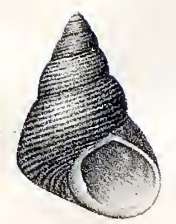Cantharidus capillaceus
Cantharidus capillaceus is a species of sea snail, a marine gastropod mollusc in the family Trochidae, the top snails.[1]
| Cantharidus capillaceus | |
|---|---|
 | |
| Drawing of a shell of Cantharidus capillaceus | |
| Scientific classification | |
| Kingdom: | Animalia |
| Phylum: | Mollusca |
| Class: | Gastropoda |
| Clade: | Vetigastropoda |
| Order: | Trochida |
| Superfamily: | Trochoidea |
| Family: | Trochidae |
| Genus: | Cantharidus |
| Species: | C. capillaceus |
| Binomial name | |
| Cantharidus capillaceus (Philippi, 1848) | |
| Synonyms | |
| |
Subspecies
Former subspecies within this species included:
- Cantharidus capillaceus capillaceus, the nominate subspecies
- Cantharidus capillaceus coruscans (Hedley, 1916): synonym of Cantharidus capillaceus
Description
The length of the shell varies between 13 mm and 28 mm. The imperforate shell has an ovate-conical shape. It is nearly smooth. Its sculpture consists of very fine dense spiral striae, leaving narrow and shallow grooves between them, sometimes nearly obsolete.
Colour: deep purple or reddish-grey, sometimes with a few white dots. The apex is usually pink. The epidermis is thin, often shining, easily rubbed off.
The spire is conical. Its sides are slightly convex. The apex is subacute. The protoconch is conoidal, consisting of 3 convex spirally striate whorls. The whorls number 6 to 7. They are slightly convex, the last rounded or obtusely angular. The base of the shell is flatly convex. The suture is linear, slightly impressed. The aperture is less than one-half the length of the shell. It is ovate, oblique, iridescent within and lirate. The outer lip is convex, effuse on meeting the basal lip, with a sharp, finely denticulate edge. The columella is subvertical, with a slight swelling in the middle. The inner lip is expanded in a callous pad over the umbilical tract. There is a thin callus on the parietal wall.[2]
Distribution
This marine species endemic to New Zealand and occurs off Auckland and the Campbell Islands.
References
- Rosenberg, G. (2013). Cantharidus capillaceus (Philippi, 1849). Accessed through: World Register of Marine Species at http://www.marinespecies.org/aphia.php?p=taxdetails&id=598216 on 2014-01-16
- Suter H. (1913-1915), Manual of New Zealand Mollusca; Wellington, N. Z. :J. Mackay, govt. printer,1913-1915 (described as Cantharidus pruninus)
- Powell A. W. B., New Zealand Mollusca, William Collins Publishers Ltd, Auckland, New Zealand 1979 ISBN 0-00-216906-1
- Marshall, B.A. 1998: The New Zealand Recent species of Cantharidus Montfort, 1810 and Micrelenchus Finlay, 1926 (Mollusca: Gastropoda: Trochidae). Molluscan Research 19: 107-156 (p. 130)
External links
- "Cantharidus capillaceus". Gastropods.com. Retrieved 15 January 2019.
| Wikimedia Commons has media related to Cantharidus capillaceus. |